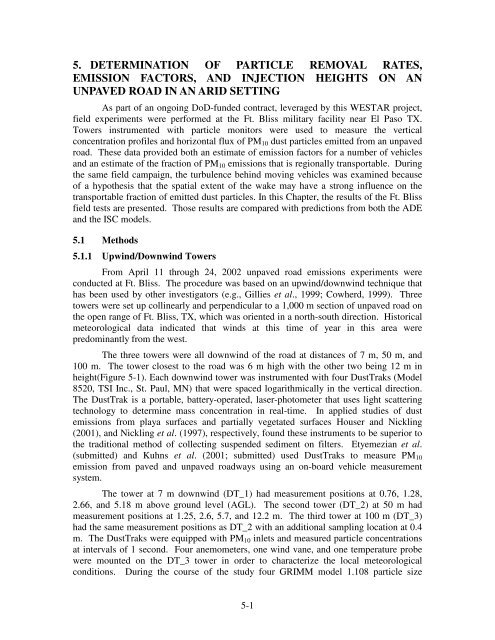FIELD TESTING AND EVALUATION OF DUST DEPOSITION AND ...
FIELD TESTING AND EVALUATION OF DUST DEPOSITION AND ...
FIELD TESTING AND EVALUATION OF DUST DEPOSITION AND ...
You also want an ePaper? Increase the reach of your titles
YUMPU automatically turns print PDFs into web optimized ePapers that Google loves.
5. DETERMINATION <strong>OF</strong> PARTICLE REMOVAL RATES,<br />
EMISSION FACTORS, <strong>AND</strong> INJECTION HEIGHTS ON AN<br />
UNPAVED ROAD IN AN ARID SETTING<br />
As part of an ongoing DoD-funded contract, leveraged by this WESTAR project,<br />
field experiments were performed at the Ft. Bliss military facility near El Paso TX.<br />
Towers instrumented with particle monitors were used to measure the vertical<br />
concentration profiles and horizontal flux of PM 10 dust particles emitted from an unpaved<br />
road. These data provided both an estimate of emission factors for a number of vehicles<br />
and an estimate of the fraction of PM 10 emissions that is regionally transportable. During<br />
the same field campaign, the turbulence behind moving vehicles was examined because<br />
of a hypothesis that the spatial extent of the wake may have a strong influence on the<br />
transportable fraction of emitted dust particles. In this Chapter, the results of the Ft. Bliss<br />
field tests are presented. Those results are compared with predictions from both the ADE<br />
and the ISC models.<br />
5.1 Methods<br />
5.1.1 Upwind/Downwind Towers<br />
From April 11 through 24, 2002 unpaved road emissions experiments were<br />
conducted at Ft. Bliss. The procedure was based on an upwind/downwind technique that<br />
has been used by other investigators (e.g., Gillies et al., 1999; Cowherd, 1999). Three<br />
towers were set up collinearly and perpendicular to a 1,000 m section of unpaved road on<br />
the open range of Ft. Bliss, TX, which was oriented in a north-south direction. Historical<br />
meteorological data indicated that winds at this time of year in this area were<br />
predominantly from the west.<br />
The three towers were all downwind of the road at distances of 7 m, 50 m, and<br />
100 m. The tower closest to the road was 6 m high with the other two being 12 m in<br />
height(Figure 5-1). Each downwind tower was instrumented with four DustTraks (Model<br />
8520, TSI Inc., St. Paul, MN) that were spaced logarithmically in the vertical direction.<br />
The DustTrak is a portable, battery-operated, laser-photometer that uses light scattering<br />
technology to determine mass concentration in real-time. In applied studies of dust<br />
emissions from playa surfaces and partially vegetated surfaces Houser and Nickling<br />
(2001), and Nickling et al. (1997), respectively, found these instruments to be superior to<br />
the traditional method of collecting suspended sediment on filters. Etyemezian et al.<br />
(submitted) and Kuhns et al. (2001; submitted) used DustTraks to measure PM 10<br />
emission from paved and unpaved roadways using an on-board vehicle measurement<br />
system.<br />
The tower at 7 m downwind (DT_1) had measurement positions at 0.76, 1.28,<br />
2.66, and 5.18 m above ground level (AGL). The second tower (DT_2) at 50 m had<br />
measurement positions at 1.25, 2.6, 5.7, and 12.2 m. The third tower at 100 m (DT_3)<br />
had the same measurement positions as DT_2 with an additional sampling location at 0.4<br />
m. The DustTraks were equipped with PM 10 inlets and measured particle concentrations<br />
at intervals of 1 second. Four anemometers, one wind vane, and one temperature probe<br />
were mounted on the DT_3 tower in order to characterize the local meteorological<br />
conditions. During the course of the study four GRIMM model 1.108 particle size<br />
5-1
















